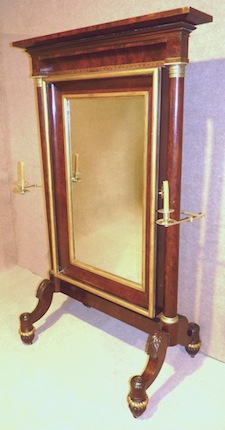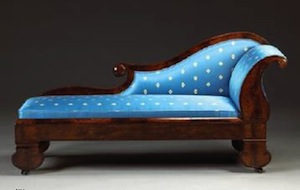Duncan Phyfe: Master Cabinetmaker in New York
Duncan Phyfe: Master Cabinetmaker in New York has opened at the Metropolitan Museum in New York City, and it is an absolute treat for both the mind and the eyes. If you have any interest at all in American decorative arts you must plan on attending.
Co-curated by Peter Kenny of the Met and Michael Brown of the Museum of Fine Arts in Houston, both recognized authorities on Phyfe, the exhibition will be at the Met until May 6, 2012, when it moves to the Museum of Fine Arts in Houston from June 20 to September 11, 2012.
The rooms in the exhibition are arranged to show Phyfe's work in chronological order. Phyfe was born in Scotland in 1768 and immigrated to America and settled in Albany, New York, in 1784. By 1792, he is recorded as living in New York City, and by 1795, he had opened his own shop on Partition (later Fulton) Street. The earliest documented piece of Phyfe furniture was made in 1807. What did he produce between his arrival in America and 1807? We just don't know.
|
The First Room
Phyfe's first stylistic period (1805-1820), known as the Grecian Style, is presented in the first room of the exhibition.
By the early 1810s, Phyfe had become New Yorks, premier cabinetmaker. He had probably stopped making furniture personally by this time. We can only guess that at the height of his workshop's production, there were as many as 25 cabinetmakers working for him. (I have seen estimates of up to 100 workers, but that is totally unrealistic in this period. Remember that this precedes the Industrial Revolution, and everything was made painstakingly by hand.) A visitor to the shop in 1816 wrote back to friends in Charleston, South Carolina, that "Mr. Phyfe is so much the United States rage, that it is with difficulty now, that one can procure an audience even of a few moments." I love this phrase: "the United States rage"! |  
A Phyfe cluster column card table from the Artemis Gallery Collection.
|
This room includes several dozen pieces of furniture that make an awe-inspiring sight. There are reeded surfaces everywhere; curule bases on settees, stools, and chairs; carved lyre backs on chairs; trick leg-and-cluster column card tables; caned seats on chairs and settees. I suspect that these are the kinds of pieces most closely associated with Phyfe in the minds of most people. The main motifs are carved, almost always in mahogany, occasionally in satinwood. The carvings include acanthus leaves running down columns and legs, swags and tassels, bowknots, and lots of reeding on stiles, rails, and legs. And then there are those fabulous sofas with incurvate arms, reeded legs, and wonderful carved tripartite crest rails. It's amazing how much can be done with just mahogany and carving. This is my favorite room.
The Second Room
The second room represents the next period in Phyfe's work, referred to as Ornamented Grecian Style. It begins about 1815, overlapping the previous style, and ends around 1830. During this period, Phyfe used ornamentation of all kinds. There was gilding of carved animal paw feet, gilt-patinated ormolu mounts on aprons, marble tops on pier tables, stenciling on table tops and table skirts. In addition to mahogany, Phyfe used lots of figured rosewood veneers as well as brass string inlay on the tops and skirts of tables. And a new form of card table came into being during this period: it featured exotic carved caryatids or griffins or other animals supporting the tops. Furniture during this period was made ostentatious and dramatic. Many people consider this to be peak Phyfe and among the finest furniture ever produced in this country.
|  
A Phyfe cheval glass from the Artemis Gallery Collection.
| The Third Room
The last room features furniture in the Grecian Plain Style (1830 to 1847). It is characterized by architectural forms of furniture, like box sofas, finished with dazzling mahogany veneers and no other ornamentation. There is no gilding and no ormolu mounts. It is also referred to as Restauration Style as it coincides with the restoration of the French monarchy. Furniture during this period was very conservative.
|
 
A Phyfe Recamier from the Artemis Gallery Collection
|
In 1837, Phyfe's two sons, William and James, joined the business and the name changed to D. Phyfe & Sons. In 1840, William left the firm, and the name changed again to D. Phyfe & Son. Phyfe closed the shop in 1847 Phyfe closed the shop and retired at the age of 79. He was a rich man, leaving an estate valued at over $300,000 when he died in 1854.
Additional Resources
If you are unable to visit the exhibition, purchase the 302-page hardcover catalog. It includes biographical information in great detail, an analysis of the different stylistic periods of Phyfe's work, and a complete listing of all 67 pieces of furniture on display (along with 23 more pieces in the appendix). This book is available online at Amazon.com for about $41, which is an outstanding bargain.
If the Exhibition has inspired you to read more about Phyfe, there are two earlier books were written about him that are still relevant: Furniture Masterpieces of Duncan Phyfe, by Charles Cornelius, 1922 (this is the catalog of the last Phyfe exhibition at the Met, available as a Dover paperback reprint), and Duncan Phyfe and the English Regency, 1795-1830," by Nancy McClelland, 1939 (also available as a Dover paperback reprint).
|